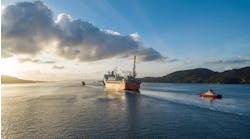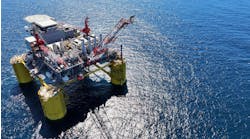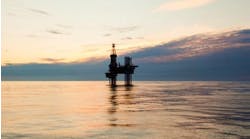Map shows route of proposed PNG export pipeline, terminating in Brisbane.
Phillips' plan for a gas export pipeline from Bayu-Undan to Northern Australia may prompt Papua New Guinea (PNG) to push forward its planned gas export pipeline. Two schemes have been proposed to exploit PNG's untapped gas, most of which lies onshore.
The PNG LNG project, which was favored by BP and Exxon before BP sold out to local interests, focused on the giant undeveloped Hides Field, while the Gas to Queensland (GTQ) project would be supplied initially by associated gas from the Chevron-operated Kutubu fields. Progress on the former has faltered since 1998, due to over-supply of LNG in southeast Asia. The GTQ project has also slowed of late due to negative commercial indicators.
Topping the list is the low gas sales price in Queensland, which could render the GTQ project only marginally economic, according to PNG's Department of Petroleum and Energy. However, analysis suggests that on balance, the government would be advised to move ahead with the project rather than wait for the gas price to rise. Further delays could also open the way to increased competition from Bayu-Undan and other Timor Sea fields through northern Australia's proposed gas trunkline network.
$3.5 billion investment
The Department's review was outlined at this year's PNG Petroleum Convention in Port Moresby, in a paper by Dominic Sebong and Tony Mackay. They pointed out that GTQ would be Papua New Guinea's largest petroleum-related investment, at an estimated $3.5 billion, 60% of which would be spent in PNG. It would involve construction of a 3,200-km-long pipeline both overland and subsea across the Torres Strait, eventually terminating in Brisbane.
PNG's proven gas reserves total around 14 tcf, with perhaps a further 35 tcf waiting to be discovered, according to geologists. Current production is miniscule, and derived solely from the Hides Field to provide electricity for the Porgera gold mine. Other gas developments have been proposed for domestic purposes including power generation in Port Moresby.
In 1997, the government created a Gas Utilisation Strategy Task Force to study potential uses for the gas, including GTQ and PNG LNG. The Petroleum and Energy department was called on to make provisional calculations of the economics of the various schemes.
A study financed by the World Bank and commissioned from the engineering firm Worley put Porgera electricity on top, with a calculated return of $6.16/million BTU, while the GTQ was rated only at $2.24/million BTU, $0.80 below the estimate for the LNG scheme.
This implied that an LNG project should take preference over GTQ. But the authors pointed out that the former is a longer-term project, liable to be further delayed by the continuing market saturation in the Far East, while GTQ would require gas in the near future. In revenue terms, GTQ would also emerge a clear winner over a 20-year period, according to Worley, bringing in $847 million of government revenue in 1998 terms compared to $446 million for the LNG scheme.
GTQ clear winner
When GTQ was first proposed in 1997, the projected gas sales price was $2.31 per giga-joule. The provisional rate agreed subsequently with buyers in Queensland was 30% lower at $1.65/GJ - this was due to increased competition in the state from coal-fired power, and the decline of the Australian dollar against the US dollar. This agreed price cannot be renegotiated, which in turn means lower than anticipated tax revenues to PNG. Taking into account pipeline and gas processing tariffs, Sebong and Mackay estimate the netback sales price and wellhead value as follows:
- Sale price, $1.98
- Wet gas pipeline, $0.32
- Marine terminal, $0.19
- Dry gas pipeline, $0.22
- Australian pipeline, $0.98
- Wellhead value, $0.27
This is a very low figure, they suggest, and would lead to correspondingly low royalties and development levies. With $2 billion-plus anticipated for upfront capital investment (including $415 million for the submarine section of the pipeline), this looks to be a very expensive project, they conclude. "Since the infrastructure will be owned and operated by different parties from the upstream parties, the wellhead value will be very sensitive to the sales volume. The more volumes put through the pipeline, the lower the unit costs of production and the better the wellhead value."
The GTQ team is working to improve the economics of the project; some of the upstream parties are insisting on returns of 16% or higher. "The risk of investing in PNG is very high," the authors point out, "and they are also competing for investment funds from their parent companies which would easily commit the funds to other projects where returns are betterellipse"
Supply schedule
IPC's Pandora gas field, discovered in the Gulf of Papua in 1988, was an early alternative contender to supply gas to northern Queensland. According to another paper at the convention by Michael McWalter, an Adviser to the Department of Petroleum and Energy, IPC, having garnered initial market interest in Queensland, eventually sold its technical and marketing studies for this project to Chevron, which realized that it too had available gas that could be monetized. Chevron already had compression at Kutubu and was reinjecting up to 150 MMcf/d, largely to maintain reservoir pressure.
Once Chevron became involved, the project evolved rapidly and the conceptual pipeline grew larger and longer. A factor favoring Kutubu's gas was that it was sweet and rich in NGLs, whereas Pandora's gas has up to 6,000 ppm of hydrogen sulfide. Also, Kutubu's gas was readily available and development would enhance the field's oil and liquids production. Pandora, in contrast, lay remote and offshore in 400 ft of water. However, the Pandora fields, being physically closer to Australia, could still be brought into the supply equation at some point, according to McWalter.
Current thinking for the GTQ scheme is to feed gas initially from the Kutubu area, then bring in further supplies from Hides in 2006. The projected rate of return from the upstream investment in Kutubu is far higher, at 30%, due to the value of the incremental oil, condensates and natural gas liquids (NGL) that would be produced.
The authors conclude that tax revenues and other economic benefits from the GTQ project will be much lower than first predicted. But the current state of PNG's economy warrants a prompt start.




